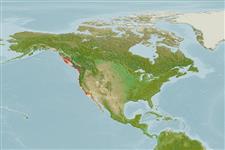Common names from other countries
>
Ovalentaria/misc (Various families in series Ovalentaria) >
Embiotocidae (Surfperches)
Etymology: Embiotoca: Greek, embios = permanent, for all the life + Greek, tokos,-oy = birth (Ref. 45335); lateralis: lateralis meaning lateral - referring to its blue stripes (Ref. 6885).
More on author: Agassiz.
Environment: milieu / climate zone / depth range / distribution range
Ecologia
marino demersale; distribuzione batimetrica ? - 21 m (Ref. 2850). Subtropical; 58°N - 29°N, 138°W - 115°W
Eastern Pacific: Wrangell, southeastern Alaska to Point Cabras, northern Baja California, Mexico.
Size / Peso / Age
Maturity: Lm ? range ? - ? cm
Max length : 38.0 cm TL maschio/sesso non determinato; (Ref. 2850); Età massima riportata: 10 anni (Ref. 56049)
Spine dorsali (totale): 10 - 11; Raggi dorsali molli (totale): 23-25; Spine anali 3; Raggi anali molli: 29 - 33. Copper ground color with dark brown overlay on back; a series of about 15 blue horizontal stripes below lateral line; head with several series of blue spots and stripes; fins coppery; dark areas on anterior part of rayed dorsal, base of caudal fin, anterior part of anal, and distal halves of pelvic fins (Ref. 6885).
Adults occur in rocky coasts and kelp beds, occasionally in sandy surf near rocks (Ref. 2850). Feed on small crustaceans, worms, and mussels; occasionally on herring eggs (Ref. 4925). Viviparous, female carries the developing young (Ref. 205).
Life cycle and mating behavior
Maturità | Riproduzione | Deposizione | Uova | Fecundity | Larve
Viviparous, female carries the developing young (Ref. 205).
Eschmeyer, W.N., E.S. Herald and H. Hammann, 1983. A field guide to Pacific coast fishes of North America. Boston (MA, USA): Houghton Mifflin Company. xii+336 p. (Ref. 2850)
IUCN Red List Status (Ref. 130435)
CITES (Ref. 128078)
Not Evaluated
Threat to humans
Harmless
Human uses
Pesca: commerciale; Pesce da pesca sportiva: si; Acquario: Acquari pubblici
Informazioni ulteriori
BibliografiaAcquacolturaProfilo di acquacolturaVarietàGeneticaElectrophoresesEreditarietàMalattieElaborazioneMass conversion
Strumenti
Special reports
Download XML
Fonti Internet
Estimates based on models
Preferred temperature (Ref.
115969): 9.3 - 15.4, mean 10.7 (based on 149 cells).
Phylogenetic diversity index (Ref.
82804): PD
50 = 0.7500 [Uniqueness, from 0.5 = low to 2.0 = high].
Bayesian length-weight: a=0.01905 (0.00831 - 0.04372), b=2.97 (2.77 - 3.17), in cm Total Length, based on LWR estimates for this (Sub)family-body shape (Ref.
93245).
Trophic level (Ref.
69278): 3.3 ±0.49 se; based on food items.
Resilienza (Ref.
120179): Medio, tempo minimo di raddoppiamento della popolazione 1.4 - 4.4 anni (tm=3; tmax=10).
Fishing Vulnerability (Ref.
59153): Low to moderate vulnerability (28 of 100).
